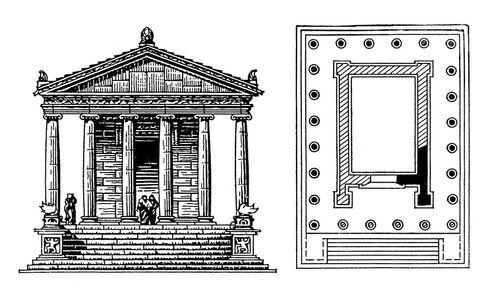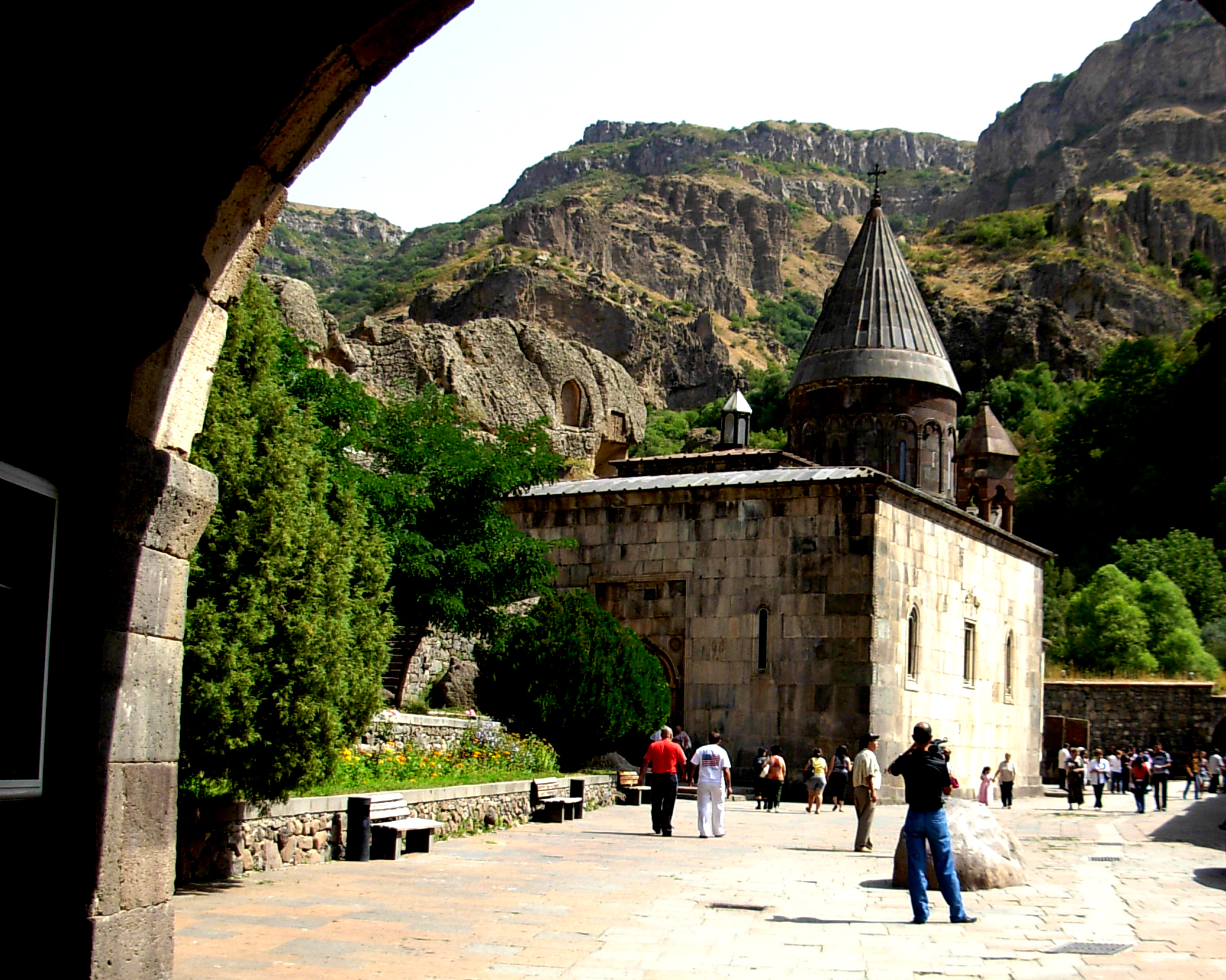|
Duration 6-7 hours
First Stop.
The fortress of Garni and Temple
There are many things to see when travelling to these
ancient places, one of them the road itself, surrounded by
amazing landscape and nature, the road to Geghard and
Garni one of the most beautiful in Armenia. The road
follows the Azat river gorge and continues to the Geghard
village and monastery.
Every region and place in Armenia is known for its local
produce and specialties. Garni is famous for lavash
(Armenian, thin bread), cheese, yogurt, apples, walnuts,
hazelnut and almonds. On your way to Garni you will see
local farmers selling canned greens, almonds, dried fruits
and other local produce. Stop by and get some canned "sindrik"
or "bokhi" pickled greens from local mountains. Halfway to
Garni however, take a few minutes to look at the Charents
Arch. The arch itself is not what you stop for, but for
the great view of famous biblical Ararat Mountain, which
it frames on a clear day.
 
The fortress of Garni and Temple are
situated in the village of the same name. When you get to
Temple, it will remind you of a somewhat plain Parthenon.
It was built in the first century AD and was dedicated to
a heathen god Mithra, the god of the sun whose figure
stood in the depth of the sanctuary. The temple was
destroyed in 1679 in an earthquake, but was reconstructed
in 20th century. (You can recognize the new stones by
their lack of carving, which allows you to appreciate the
originals.) It is an excellent reconstruction and a very
worthwhile place to visit. There are also ruins of mosaic
ancient baths and summer residences of Armenian kings. The
structures of Garni combine elements of Hellenistic and
Armenian culture, which are an evidence of antique
influences and the distinctive building traditions of the
Armenian people. In its style, the temple, resembles
similar structures in Syria (Baalbek) and Rome. Its
architectural shapes are basically-Hellenistic.

Strategically, the place for building this
fortress was very cleverly chosen. The fortress of Garni
stands on a triangular cape, which dominates the locality
and juts into the river. A deep gorge and steep mountain
slopes serve as a natural impregnable obstacle, and
therefore the fortress wall was put up only on the side of
the plain. It was put together of large square-shaped
slabs of basalt placed flat on top of each other without
mortar and fastened together with iron cramps sealed with
lead.
The artistic merit and uniqueness of its monuments place
Garni among outstanding creations of architecture of world
importance. The structures of the fortress of Garni are in
perfect harmony with the surrounding nature. The fortress
is situated in a picturesque mountain locality and
commands a broad panorama of orchards, fields and mountain
slopes covered with motley carpets of varicoloured
grasses, of the jagged and precipitous canyon of the Azat
river.


Second Stop.
Geghard monastery
Northeast of Garni, higher up the gorge of the Azat River,
there is a magnificent monument of medieval Armenian
architecture - Geghard monastery. It is amongst the top
tourist sites in Armenia and is in the list of UNESCO's
world heritage list. The cave church of St. Astvatsatsin
(Holy Mother of God) of the 4th century is still
accessible by the entrance of the renovated territory of
the monastery. The name Geghard means Lance as the spear
that pierced our Lord Jesus Christ's side during the
crucifixion later was brought to Armenia by one of the 12
apostles of Christ - St. Thaddeus (Judas).
The architecture of the monastery is very rich. You can
find survivals from the early 4th century to the Zakarids'
period of late 13th century. The mausoleum of Proshyans'
is another famous piece of art. Various khachkars
(cross-stones), an Armenian phenomenon, can be traced
here. The setting of the complex is inspiring and
provoking a healthy spiritual retreat.


Nothing has remained of the structures of Geghard.
According to Armenian historians of the 4th, 8th and 10th
centuries the monastery comprised, apart from religious
buildings, well-appointed residential and service
installations. Geghard suffered greatly in 923 from Nasr,
a vice-regent of an Arabian caliph in Armenia, who
plundered its valuable property, including unique
manuscripts, and burned down the magnificent structures of
the monastery. Earthquakes also did it no small damage.
The existing ensemble dates back to the 12th-13th
centuries, the time of the flourishing of national
culture, especially architecture. Under the princes of
Zakarids' the main chapel as well as the same cave
churches were built. In the second half of the 13th
century the monastery was bought by Proshyan dynasty. Over
a short period, they built the cave structures which
brought Geghard well-merited fame - the second cave
church, the family sepulcher of Proshyans'.
Erected over a short period, the monuments make up a
single architectural and artistic whole in which ground
structures are compositionally and stylistically connected
with the premises hewn in rock.
 Built in 1215, the main cathedral belongs, in its spatial
arrangement and layout, to a type of structure spread in
Armenia in the 10th-14th centuries - rectangular in the
plan, on the outside, and cross-winged domed interior with
two-storey annexes in the corners of the central crossing.
The architectural forms of the building are well
proportioned and harmonious. The pilasters and
half-columns, crowned with pointed arches and spherical
pendentives are fortunately coordinated with the cupola
resting on a high drum. Built in 1215, the main cathedral belongs, in its spatial
arrangement and layout, to a type of structure spread in
Armenia in the 10th-14th centuries - rectangular in the
plan, on the outside, and cross-winged domed interior with
two-storey annexes in the corners of the central crossing.
The architectural forms of the building are well
proportioned and harmonious. The pilasters and
half-columns, crowned with pointed arches and spherical
pendentives are fortunately coordinated with the cupola
resting on a high drum.
The outward appearance of the cathedral is organically
coordinated with its interior. The gentle divisions of the
lower hulk are crowned with a graceful cupola which
emphasizes the predomination of the vertical line in the
structure's composition. It is also reflected in the
arrangement of the main decorative elements of the
facades, especially of the southern one. The Proshyans'
sepulcher and the second cave church were hewn in 1283.
The former consists of two sections - the big one, which
served as a vestry, and the small one, connected with it
by two archways; in its floor there are burial vaults. In
their proportions both sections are rather low, which is
emphasized by a heavy column, the segmental shape of
archways and a low through vault with a light opening at
the top. All this is meant to convey the purpose of this
premise as a burial place and as a passageway to the
church which was probably a memorial one.
 Numerous
khachkars cut on rock surface and on the walls of the
structures or put up on the territory of Geghard in memory
of a deceased or in commemoration of someone's donation to
the monastery are richly ornamented with geometrical or
floral motives. The composition of some khachkars'
decoration is unique. The arrangement of the khachkars
emphasizes certain points of the ensemble. Numerous
khachkars cut on rock surface and on the walls of the
structures or put up on the territory of Geghard in memory
of a deceased or in commemoration of someone's donation to
the monastery are richly ornamented with geometrical or
floral motives. The composition of some khachkars'
decoration is unique. The arrangement of the khachkars
emphasizes certain points of the ensemble.
No works of applied art have survived in Geghard, the only
exception being the legendary spear, "geghard" - a shaft
with a diamond-shaped plate attached to its end; a Greek
cross with flared ends is cut through the plate. In 1687,
a special case was made for it, now kept in the museum of
Echmiadzin - Holly See of Armenian Church.
 From here you walk up a path which has a few vendors of
souvenirs and snacks. (try the sweet "sujukh", sweet
lavash and gata if you have never tasted them before). You
then reach the entrance to the compound which is
surrounded by high walls on three sides and the mountain
on the fourth. Inside, you can enter the churches which
are interconnected. There is some water in a small
pond/stream in one chamber carved into the mountain, and
the acoustics are great throughout. If you climb up stone
stairs located on the left side of the church, you will
pass some very finely carved khatchkars. From here you
enter yet another chamber. This chamber, though not much
to look at, had the greatest acoustics I ever saw
demonstrated to me when the monk who was guiding us began
to sing. His voice was beautiful to begin with, but when
he began to sing in this chamber it was hard to believe a
large choir was not singing praise at the top of their
lungs... that it was only one man. Also in the corner of
this chamber, if you look down you will see a hole that
goes through which allows the lower churches interior to
be seen. Outside of the monastery complex, before you
enter the gates, you will notice some caves perhaps and
ruins to the left of the entrance. If you are in shape,
you should climb up in this area, which has a bunch of
little cave-rooms and is quite interesting. From here you walk up a path which has a few vendors of
souvenirs and snacks. (try the sweet "sujukh", sweet
lavash and gata if you have never tasted them before). You
then reach the entrance to the compound which is
surrounded by high walls on three sides and the mountain
on the fourth. Inside, you can enter the churches which
are interconnected. There is some water in a small
pond/stream in one chamber carved into the mountain, and
the acoustics are great throughout. If you climb up stone
stairs located on the left side of the church, you will
pass some very finely carved khatchkars. From here you
enter yet another chamber. This chamber, though not much
to look at, had the greatest acoustics I ever saw
demonstrated to me when the monk who was guiding us began
to sing. His voice was beautiful to begin with, but when
he began to sing in this chamber it was hard to believe a
large choir was not singing praise at the top of their
lungs... that it was only one man. Also in the corner of
this chamber, if you look down you will see a hole that
goes through which allows the lower churches interior to
be seen. Outside of the monastery complex, before you
enter the gates, you will notice some caves perhaps and
ruins to the left of the entrance. If you are in shape,
you should climb up in this area, which has a bunch of
little cave-rooms and is quite interesting.
|


